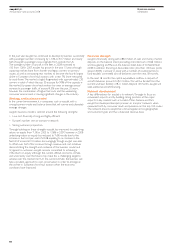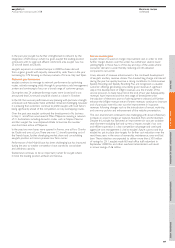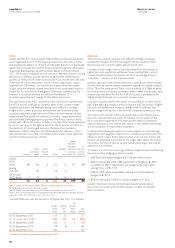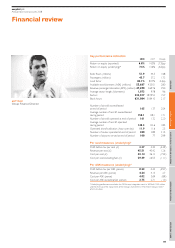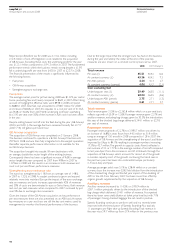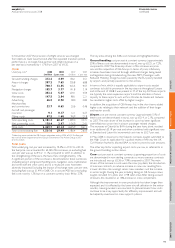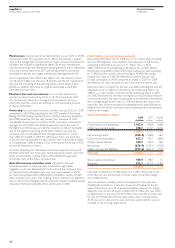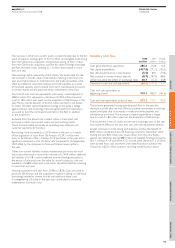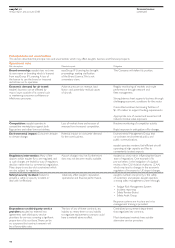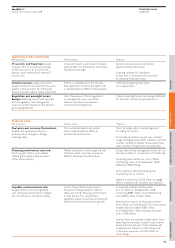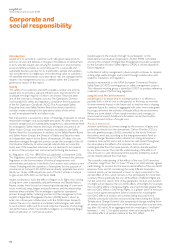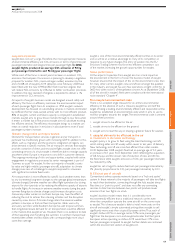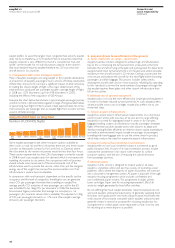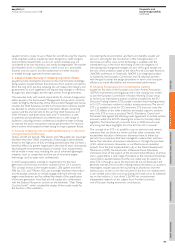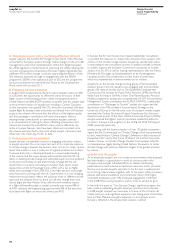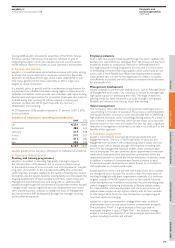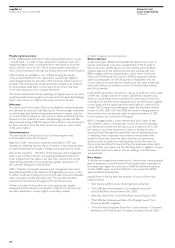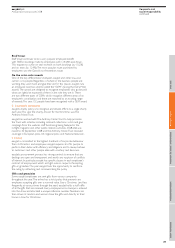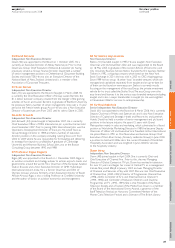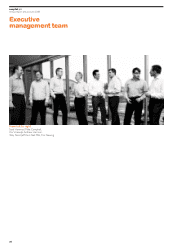EasyJet 2008 Annual Report Download - page 18
Download and view the complete annual report
Please find page 18 of the 2008 EasyJet annual report below. You can navigate through the pages in the report by either clicking on the pages listed below, or by using the keyword search tool below to find specific information within the annual report.easyJet supports the industry through its participation on the
International Civil Aviation Organisation (ICAO) FRMS committee
and now the concept of Fatigue Risk Management has been accepted
by the European Aviation Safety Agency (EASA) it will be adopted in
future regulation.
In the field of safety management systems, easyJet continues to develop
cutting edge methodologies and toolsets through collaboration with
academic institutions and regulators.
easyJet is represented on the EASA European Commercial Aviation
Safety Team (ECAST) working group on safety management systems.
This influential working group is tasked by ECAST to produce reference
material to support forthcoming regulation.
easyJet and the environment
easyJet’s goal is to ensure that its existing business is as efficient as
possible, both in the air and on the ground, to find ways to minimise
its environmental impact in the future and to lead the way in shaping
a greener future for aviation. In aggregate with other man-made green
house gas emissions the activities of easyJet affects the environment.
Below are some details of how easyJet monitors and manages its
environmental impact. Additional information can be found within
the environment section of easyJet.com.
Aviation emissions
Aviation contributes to climate change by the emission of gases and
particulates directly into the atmosphere. Carbon Dioxide (CO2) is
the only greenhouse gas (GHG) controlled by the Kyoto Protocol
that airlines emit and, according to the Intergovernmental Panel on
Climate Change, “Because carbon dioxide has a long atmospheric
residence time (≈100 years) and so becomes well mixed throughout
the atmosphere, the effects of its emissions from aircraft are
indistinguishable from the same quantity of carbon dioxide emitted
by any other source.” The scientific understanding of the effects of
CO2emissions is well advanced and the quantity emitted by aviation
can be directly derived from fuel burn.
The scientific understanding of the effects of the non-GHG emissions
of aviation range from “fair” to “poor”. There is no internationally agreed
methodology to account for the environmental effects of the non-GHG
emissions from aircraft, considering the vastly different timescales
involved (which can be measured in hours or days) compared to the
climate effect of CO2, which remains in the atmosphere for more than
a century. More specifically, the non-GHG affects of different flights are
not the same. The season, time of day, geographic location and duration
of a flight will all influence the non-GHG effects of the flight. For example,
the non-GHG effects of long-haul flights are proportionally greater than
the non-GHG effects of short-haul flights, as a greater share of emissions
occur in the upper atmosphere. Several concepts for including the
non-GHG effects of aviation are currently being discussed in the
scientific community with the most promising metric being the Global
Temperature Change Potential (the temperature change resulting from
an aviation induced perturbation of the atmosphere after a certain time,
e.g. after 100 years). At an aggregate level this would give a “multiplier”
between 1.1 and 1.2 for global aviation, when accounting for the
non-GHG effects of aviation relative to the CO2effect.
Corporate and
social responsibility
Introduction
easyJet aims to provide its customers with safe, good value, point-to-
point air services and believes in the goal of excellence of achievement
in all its activities. easyJet sees striving for excellence in environmental,
social and ethical activities as a key behaviour for a successful and
sustainable business, positive for its shareholders, people and suppliers,
and considerate to its neighbours whilst delivering value to customers.
All identified environmental, social and ethical risks are managed within
easyJet’s risk management process, as defined within the Corporate
governance section of the report.
Safety
The safety of its customers and staff is easyJet’s number one priority.
easyJet aims to provide a safe and efficient work environment for all
its people, the large majority of whom are aircrew. They have been
one of the mainstays of easyJet’s success. The Operations Director
is accountable for safety and regulatory compliance for the purposes
of the Air Operators Certificate (AOC). The Accountable Safety
Executive chairs the Safety Review Board that meets monthly to
consider matters relating to the operational safety of the airline
as well as employee health and safety issues.
Risk transparency is assured by a series of meetings, structured to include
responsible managers and accountable executives. All safety reports are
assessed, categorised and subsequently assigned to a departmental head
for investigation. Safety reports and issues arising are discussed at all
Safety Action Groups and, where necessary, escalated to the Safety
Review Board for consideration. In addition to the Safety Review Board
and Safety Action Groups, the Director of Safety and Security makes
an independent report to the Board of easyJet plc. All safety risks are
therefore managed through this process (under the oversight of the UK
Civil Aviation Authority, to whom easyJet submits data on a monthly
basis) even if the expected outcomes are not deemed to be material
in terms of the principal risks and uncertainties facing the business.
EU Regulation (EC) No 1899/2006 was published in December 2006.
This Regulation, commonly referred to as EU-OPS, amends the previous
Regulation on the harmonisation of technical requirements and
administrative procedures in the field of civil aviation and contains a new
Annex III dealing with the operation of aeroplanes for the purpose of
commercial air transport. EU-OPS became directly applicable law across
the EU on 16 July 2008. easyJet was one of the first airlines in Europe
to gain an EU-OPS AOC on 30 March 2008.
easyJet continues to study the effect of fatigue on its flight crew looking
at long-term crew sustainability, safe performance and lifestyle factors.
Recent studies have focused on improving understanding of crew work
hours, workload, sleep, fatigue, and performance, and the relationships
between these variables. This knowledge is applied to operational
process through better rostering practice and the management of risk.
easyJet’s Fatigue Risk Management System (FRMS) team is about to
enter into a three year collaboration with the NASA Ames Research
Centre. The aim is to develop and validate methodologies with which
to assist aviation safety and to provide objective measures of physiology
and performance, which may benefit investigators in monitoring fatigue
levels of operators in commercial aviation.
easyJet plc
Annual report and accounts 2008
16


